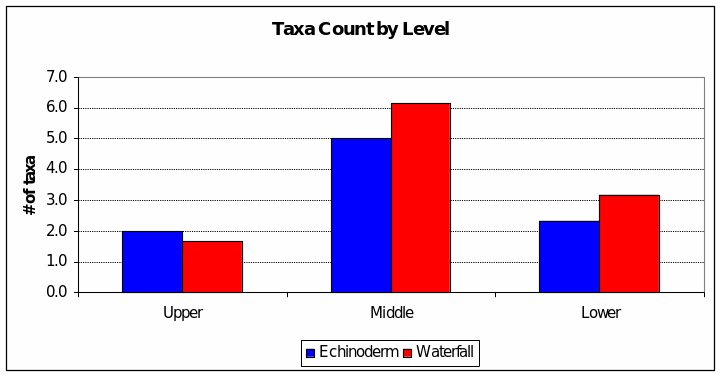Introduction/Method
The practical field survey was in the Goat Island Bay and the two study sides were Echinoderm Reef and Waterfall Reef. Akin to the baseline survey carried out by Cumming (1980), the intent of this group effort was to carry out an atlas of one transect at each site (see Fig. 1 below), recording the occurrence of predicted species and others. and determining habitats or communities across the upper, middle and lower intertidal zone.

As in the pioneering effort by Cummings, six random sample quadrants (measuring 0.25m2in area) were drawn for a total of 18 samples in each study site. Within each quadrant, the common species were counted or, in the case of seaweed and moss, proliferation estimated as a percentage of the quadrant occupied. In general, the field practical covered some of the more systematic measures recommended in the Joint Nature Conservation Committee (n.d.) ‘Marine Nature Conservation Review’ form. The recording standard for ‘Littoral Habitat (Detailed)’ includes, as this survey did, height limits and bands, zones, seabed inclination, main characterising taxa, and self-admitted survey quality (JNCC, n.d.), besides providing an exhaustive checklist of species that might be found.
Findings
Just six classes of organisms were found in the Echinoderm area (see Table 1 below). On the other hand, the exposed greywacke characteristic of the Waterfall portion of the reserve lends itself to a slightly greater variety of classes.
Table 1: Main Taxa in the Two Areas Surveyed
In general, the Waterfall area supports more classes since ray-finned fish, sponges, and Echinoidea were found only here. The more quantitative aspect of species count within class is revealed in Fig. 2 below. This shows that Waterfall Reff is more diverse in point of hosting not just one but two species of Rhodophyceae (versus none at Echinoderm, three Maxillopoda species (versus two), and four times more bivalve mollusc species.

On the other hand, both areas host about the same number of Gastropod species.
In both cases, as Fig. 3 below strongly supports, biodiversity in point of discrete taxa is greatest in the middle level, 12.5 to 15.5 metres from the waterline at low tide.

Examining taxa counts by individual samples, one finds that these are consistent with the proportions when averaged by level in Fig. 3 above. The difference is that the sheer scarcity of organisms at the upper level of Echinoderm Reef is emphasized by the fact that two thirds of the samples taken yielded nothing at all (Fig. 4 overleaf).

Counting barnacle and seaweed colonies as 1 each, we obtain the comparison of populations of individuals in Fig. 5 below. The most striking finding here is the peak individual count at upper sample 2 in the Echinoderm area. This is due to the proliferation of the gastropods Haustrum (dark rock shell) and Nerita atramentosa (black nerite) in that sample, a phenomenon not repeated elsewhere in the area or in the adjacent Waterfall Reef.

Consistent with the aforementioned low taxa count, samples three to six in Waterfall Reef upper level are remarkable for yielding no individuals at all (Fig. 5 above). At Echinoderm, individual counts are also lowest (one each) in upper level samples three to five and in lower level sample one as well.
Across the 18 samples taken in Echinoderm Reef (see Table 2 below), the red seaweed Coralina officinalis is present in fully half and is therefore the single most widespread species. This is followed closely by the gastropod Turbo smaragdus. In the same area, on the other hand, the brown seaweed Glossophora kunthii and half of all gastropods encountered were found in just one sample each.
Table 2: Most and Least Widespread, Echinoderm Reef
At Waterfall Reef, oyster borers (Lepsiella scobina) and brown barnacles (Chaemaesipho brumea) were somewhat more widespread than any other species. The fact that Cellana ornata and Chaemospiho columna ran close second attests to the greater biodiversity of the area.
Least present in Waterfall, by virtue of being found in just one sample each, were, Xiphophorus, Evechinus chloroticus, Corallina, Melagraphia aethiops, and Gelidium pusilum.
Table 3: Most and Least Widespread, Waterfall Reef
References
Cumming, A. (1980). Cape Rodney to Okakari Point Marine Reserve survey 2. Rocky shores. Leigh Marine Laboratory. The University of Auckland, New Zealand. Web.
Joint Nature Conservation Committee (n.d.). Marine nature conservation review: Site survey. 2010. Web.
Joint Nature Conservation Committee (n.d.). Marine nature conservation review: Littoral habitat (detailed). Web.